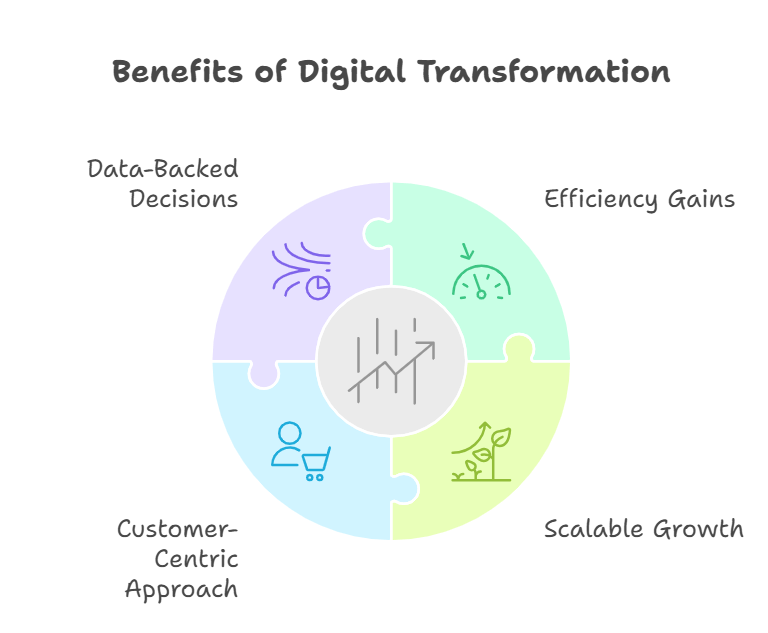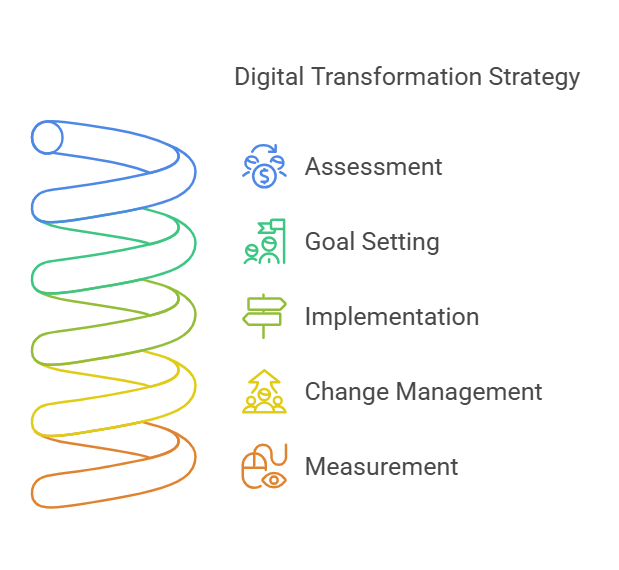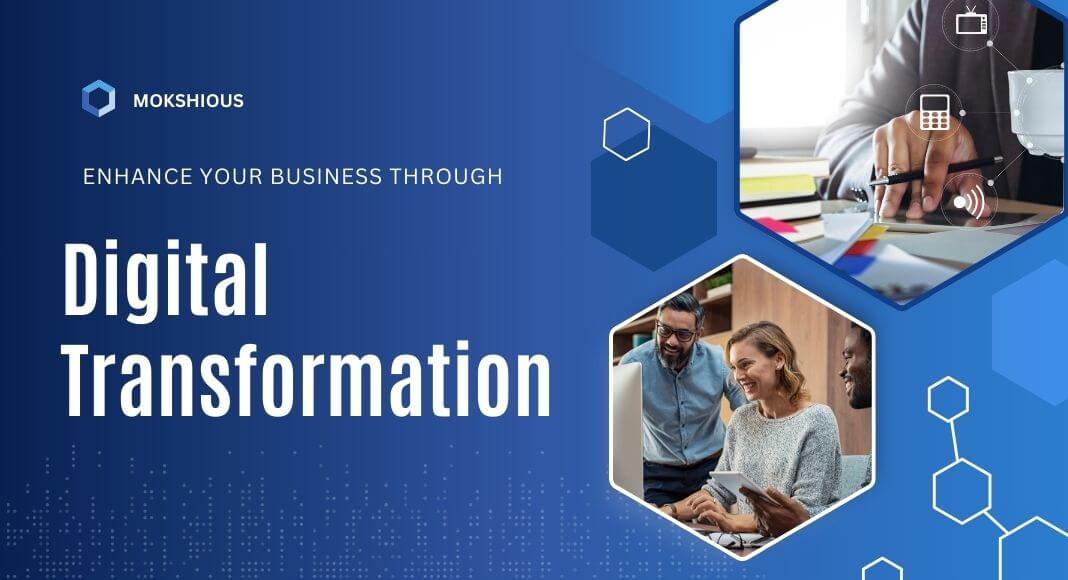Digital transformation triggers debate, inspires bold roadmaps, and captivates leaders obsessed with improving efficiency. But it’s far more than a buzzword. For an enterprise, it’s a concrete business mandate: implement the right digital technologies, refactor critical business processes, and ship compelling digital products and services.
This guide unpacks enterprise digital transformation, why it matters, where to focus, and how a pragmatic digital transformation strategy can propel a company forward. We’ll break down the benefits of enterprise digital transformation and show practical ways to handle the inevitable challenge of weaving new technology into all business areas.
Introduction: Understanding Digital Transformation
Why Is Digital Transformation Important for Enterprise Software?
At its core, digital transformation is the deliberate use of digital solutions to change how an enterprise works, what digital products it delivers, and how the business model evolves. Put simply, transformation is the process of integrating digital technology into all business areas, from marketing and data to product and sales, so the organization can run leaner, move faster, and compete harder. The payoff: higher efficiency, faster growth, real advantage.
Fact: IDC reports that worldwide Digital Transformation (DX) spending is growing at a 15.8% CAGR over 2024–2028, underscoring the scale and impact of the shift.
As enterprise digital transformation accelerates, it’s reshaping how leaders think about agility, customer-led product design, and change management. Staying ahead in the digital age isn’t optional; it’s survival.
Key Characteristics of Digital Transformation Efforts
- People & Culture: Software upgrades don’t transform a business; people do. Effective change management wins buy-in, aligns incentives, and builds a habit of continuous improvement across the company.
- Technology Integration: Companies must connect digital tools into core business processes, CRM, ERP, analytics, and automation, so data flows and decisions speed up.
- Ongoing Innovation: Treat digital transformation less like a one-off project and more like a permanent operating system. Iterate, measure, iterate again.
The Importance of Digital Transformation in Business Growth

Importance of Digital Transformation for Enterprise Success
Why does digital transformation matter? Because it reshapes business models, modernizes operations, and elevates customer experience, all at once. A mature enterprise digital transformation program delivers:
- Increased Competitiveness: Advanced digital technologies compress release cycles and help an enterprise outmaneuver slower rivals.
- Enhanced Efficiency: Streamlined business processes reduce time-to-market and operational waste.
- Better Business Outcomes: The benefits of enterprise digital transformation show up in data-driven bets, faster innovation, and expanded market share.
Market Trends: AI, IoT, and edge computing continue driving digital transformation. Organizations that embrace digital transformation early see durable growth and resilience when markets wobble.
Business Model Evolution
- Shifting Customer Expectations: Digital transformation aligns products and services to modern preferences, cloud, mobile, and subscriptions.
- New Business Opportunities: With scalable platforms, firms unlock new business models (SaaS, usage-based pricing, ecosystem plays).
Key Areas of Digital Transformation for Enterprise Software Companies
Areas of Digital Transformation That Enable Competitive Advantage
Enterprise software leaders can focus on several areas of digital transformation that improve outcomes and implement real change:
- Product Modernization: Cloud migration, best digital practices, and legacy refactoring to increase adaptability.
- Operational Efficiency: Automation + AI analytics for real-time visibility; unified comms to kill silos.
- Customer Experience: Personal, proactive digital services, intuitive UIs, predictive support.
- Data-Driven Strategy: Instrumentation and analytics to steer business strategy, track transformation success, and pivot fast.
Examples of Digital Initiatives
- Examples of digital upgrades: ML-assisted anomaly detection in SaaS; AI-driven threat hunting in cybersecurity.
- Industry Benchmarks: Top enterprise players use digital transformation to tighten collaboration, shorten dev cycles, and scale continuous delivery.
Benefits of Enterprise Digital Transformation for SaaS and Cybersecurity Companies

Benefits of Enterprise Digital Transformation
A clear enterprise digital transformation program yields compounding benefits:
- Efficiency Gains: Automate repetitive work; standardize to raise quality and speed.
- Scalable Growth: Launch digital products and services into new markets and segments.
- Customer-Centric Approach: Personalize customer journeys; use data-backed campaigns that actually resonate.
- Data-Backed Decisions: Align analytics with business goals for sharper forecasts and smarter roadmaps.
Impact on Company Revenues and Market Share
- Real-World Figures: In 2022, SaaS respondents widely reported heavy manual planning and budgeting; 73% said they spend too much time on it, highlighting how digital transformation strategy and automation can unlock capacity for revenue work.
- Competitive Positioning: A durable culture of innovation builds resilient growth and helps firms ride out market swings.
Challenges and Roadblocks in the Transformation Process

Common Challenges in Digital Transformation
Even with a clear upside, digital transformation introduces real challenge points:
- Organizational Resistance: Fear of change or job impact slows adoption.
- Legacy Infrastructure: Old software and hardware constrain agility and must be modernized.
- Lack of a Clear Strategy: Without a digital transformation roadmap and a digital transformation framework, efforts drift.
Overcoming Barriers to a Successful Digital Transformation
- Effective Planning: Tie transformation goals to concrete business objectives.
- Resource Allocation: Fund skills, time, and tooling for each digital transformation project; plan for iteration.
- Cultural Shift: Foster a culture of innovation so teams test, learn, and scale digital solutions that match market trends.
Step-by-Step Digital Transformation Strategy

Building a Digital Transformation Strategy That Delivers Results
Use a five-step flow for effective digital transformation:
- Assessment: Map current business processes, tech stack, and readiness for transformation.
- Goal Setting: Define digital transformation goals (UX, velocity, new verticals) tied to target business outcomes.
- Implementation: Prioritize enterprise digital transformation areas, analytics, DevOps, and AI automation.
- Change Management: Train, redesign workflows, and align with the company mission; address challenge hotspots.
- Measurement: Track KPIs, improve what works, and double down. This is how you get transformation success.
Practical Tips to Implement Enterprise Digital Transformation
- Pilot Projects: Prove ROI on a small surface area, then expand.
- Integration: Ensure new digital technologies fit your existing systems to avoid silos.
- Continuous Feedback: Gather user and stakeholder input; refine digital transformation initiatives continuously.
Trends in Digital Transformation for Enterprise Software
Digital Transformation Trends to Watch
- AI & Machine Learning: Automate workflows, improve prediction, and surface anomalies at scale.
- Cloud-First Adoption: Elasticity + agility + cost control.
- Cybersecurity Focus: Identity, zero-trust, advanced detection, and security are table stakes.
- Remote Collaboration. Modern digital tools for global, high-tempo teamwork.
Market Trends Driving Digital Business Transformation
- B2B Innovations: Rising b2b demand for integrated ecosystems and specialized vendor stacks.
- Real-Time Analytics: Digital transformation success hinges on fast insight → fast action.
- Edge Computing: Low-latency decisions and powerful IoT use cases.
Examples of Digital Products and Services Driving Innovation
Showcase of Successful Enterprise Digital Transformations
- Tech Giants: Microsoft, AWS, and Google demonstrate at scale how digital transformation modernizes digital products and digital services, from chatbots to serverless.
- Cybersecurity Pioneers: Threat-intel platforms using AI analytics and ML-based detection shift from reactive to proactive defense, the essence of business advantage.
Inspirational Use Cases
- SaaS Startups: Digital transformation is the integration of DevOps, agile, and continuous delivery to ship reliably at speed.
- Product Development: Hybrid cloud, containers, and microservices are the process of using digital architectures to streamline collaboration and ship frequent, stable releases.
How to Implement a Successful Enterprise Digital Transformation Framework

Best Practices for a Successful Enterprise Digital Transformation
- Develop a Digital Strategy: Connect your digital strategy with your business model so technology follows outcomes.
- Adopt a Proven Methodology: Lean, agile, DevOps, pick one and stick to it for clarity and cadence.
- Leverage Data: Warehouses, dashboards, AI analytics, and use digital metrics to steer decisions across all digital initiatives.
Building a Digital Transformation Roadmap
A solid digital transformation roadmap clarifies priorities and pace:
- Short-Term Milestones: Target one high-value business process for automation; bank a quick win.
- Long-Term Vision: Show how digital transformation scales with company expansion and market trends.
- Transformation Process: Review frequently; recalibrate to maintain transformation success.
Roadmap for Ongoing Digital Business Transformation and Growth
Sustaining Digital Transformation Success Over Time
A real digital transformation never “finishes.” It becomes how you operate:
- Continuous Improvement: Ship incremental enhancements guided by user signals.
- Adaptability: Track digital transformation trends, AI, security, customer expectations, and pivot quickly.
- Foster a Culture of Innovation: Keep curiosity alive; fund experiments; reward learning.
Linking Transformation to Measurable Business Outcomes
- KPIs to Track: Revenue growth, NPS/CSAT, operational efficiency, churn, and cycle time.
- Transformation Goals: Tie each digital transformation plan to top-level business goals so every step ladders to market relevance and brand equity.
Frequently Asked Questions (FAQ)
1) What is digital transformation, and how does it impact enterprise software companies?
To increase productivity and spur faster innovation, digital technologies are systematically incorporated into software, business operations, and business processes. Modern platforms, more sophisticated digital products, and flexible strategy frameworks that adjust to changes in the market are what enterprise software providers should expect.
2) How do we start a digital transformation strategy?
Audit your business model and tech stack. Surface challenge bottlenecks. Set measurable targets tied to business goals (revenue, cost, CSAT). Build a phased roadmap with digital tools, process redesign, and training, then execute one step at a time.
3) Why does culture matter so much?
Because change management determines whether people adopt the new way of working. A culture that prizes experimentation and learning turns digital investments into real outcomes.
4) What pitfalls derail transformation?
No clear digital transformation strategy, clinging to legacy infrastructure, and pushing tools without process change. Allocate resources, secure leadership backing, and work within a digital transformation framework to stay on track.
5) How do we measure ROI?
Set baselines before the digital transformation project. Track cost savings, growth, CSAT, and productivity. Review KPIs regularly to validate impact and keep efforts aligned with business objectives.
Conclusion: Embrace Digital Transformation for Sustained Company Success
Digital transformation is the way modern businesses compete, not a phase you wait out. Everything else begins to move when digital technologies are woven throughout the organization: quicker releases, more streamlined business procedures, and more transparent wagers. The objective remains the same whether you’re updating software, streamlining processes, or implementing a comprehensive digital transformation plan: to spur growth, increase productivity, and maintain your competitive edge. You will find new value streams, reduce friction, and improve the customer experience if you do it consciously, test, learn, and adjust.
Adopt digital solutions that reinforce your business strategy and accelerate digital business transformation, stepwise or at scale. Do that, and you strengthen competitiveness today while positioning for tomorrow. In short, digital transformation refers to the comprehensive process of using digital technologies to redefine how a business operates, competes, and scales. Integrate the right digital tools, nurture innovative thinking, and tap into digital transformation’s outsized potential. Let’s embrace digital transformation and move decisively into what’s next.
